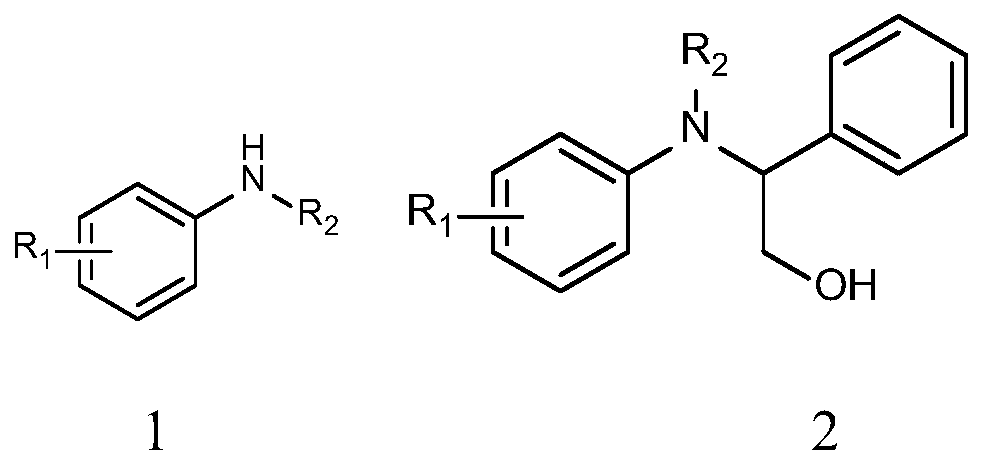On-line phenylethanol beta-amino-alcohol derivative synthesis method on basis of enzymatic aminolysis by flow chemistry
A phenethyl alcohol and amino alcohol technology, which is applied in biochemical equipment and methods, enzymology/microbiology devices, enzyme production/bioreactors, etc., can solve the problems of long reaction time, unsatisfactory conversion rate, etc. Reaction cost, high conversion and selectivity, effect of shortened reaction time
- Summary
- Abstract
- Description
- Claims
- Application Information
AI Technical Summary
Problems solved by technology
Method used
Image
Examples
Embodiment 1
[0031] Example 1: Synthesis of 2-(2-methylanilino)phenethyl alcohol
[0032]
[0033] Device reference figure 1 : Dissolve o-toluidine (2.0 mmol) in 10 mL of MeOH, and dissolve styrene oxide (2.0 mmol) in 10 mL of MeOH, and then put them into 10 mL syringes for use. 0.87g of lipase LipozymeRM IM was evenly filled in the reaction channel. Driven by the PHD2000 syringe pump, the two reaction solutions were injected at 15.6μL·min respectively. -1 The flow rate of 200 μL enters the reaction channel through the “Y” joint to carry out the reaction. The temperature of the reactor is controlled at 35°C by a water bath thermostat, and the reaction solution flows continuously in the reaction channel for 20min. The reaction results are tracked and detected by thin-layer chromatography (TLC).
[0034] The reaction solution was collected online through a product collector, the solvent was distilled off under reduced pressure, and the column was wet-packed with 200-300 mesh silica gel. ...
Embodiment 2-5
[0038] The solvent in the microfluidic microchannel reactor was changed, and the temperature was controlled to 35°C. Others were the same as those in Example 1. The results are shown in Table 1:
[0039] Table 1: Effect of solvent on reaction
[0040]
[0041]
[0042] The results in Table 1 show that when the ratio of the amount of o-toluidine and styrene oxide substrate substances is 1:1, the flow rate is 15.6 μL·min -1 , the reaction time is 20min, and the reaction temperature is 35°C. The conversion rate and selectivity of the reaction are the best when the reactor uses MeOH as the organic solvent. Therefore, the optimal solvent in the microfluidic microchannel reactor in the present invention is methanol.
Embodiment 6-9
[0044] Taking the consumption of o-toluidine as a benchmark, change the ratio of the amount of the substrate material of o-toluidine and styrene oxide in the microfluidic microchannel reactor, and control the temperature to 35 ° C. Others are the same as in Example 1, and the results are shown in Table 2. Show:
[0045] Table 2: Effect of the ratio of the amount of o-toluidine and styrene oxide substrate species on the reaction
[0046] Example
[0047] The results in Table 2 show that when the flow rate is 15.6 μL·min -1 , the reaction time is 20min, the reaction temperature is 35℃, the reactor uses MeOH as the organic solvent, with the increase of the reactant styrene oxide, the conversion rate of the reaction also increases, when the substrate is o-toluidine and benzene oxide When ethylene is 1:1, the conversion rate and selectivity of the reaction are optimal, so the ratio of the optimal amount of substrate substances in the microfluidic microchannel reactor in ...
PUM
 Login to View More
Login to View More Abstract
Description
Claims
Application Information
 Login to View More
Login to View More - R&D
- Intellectual Property
- Life Sciences
- Materials
- Tech Scout
- Unparalleled Data Quality
- Higher Quality Content
- 60% Fewer Hallucinations
Browse by: Latest US Patents, China's latest patents, Technical Efficacy Thesaurus, Application Domain, Technology Topic, Popular Technical Reports.
© 2025 PatSnap. All rights reserved.Legal|Privacy policy|Modern Slavery Act Transparency Statement|Sitemap|About US| Contact US: help@patsnap.com



